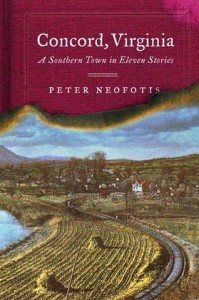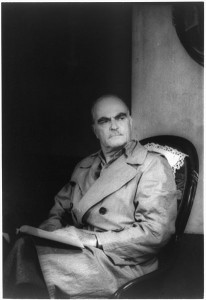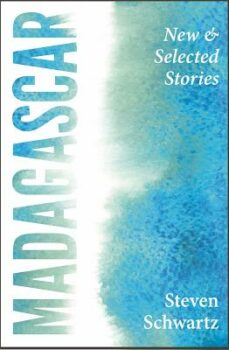 Some of my earliest education as a writer came from my grandfather. I used to sit on a tall stool at the bar in his dingy kitchen in Orlando and listen as he told stories of his time in the Navy. The war ended shortly after he enlisted, but he still sports the Bugs Bunny tattoo on his forearm, which he got one night with a few of his fellow sailors. He also loved to talk about the day he married my granny and how their marriage literally killed her mother—she died about a month after they wed. Then there were his tales about bottomless Lake Como, the small lake nearby that he swore scuba divers had searched, unable to find the bottom. And, of course, there were the legendary fights his sons (my father one of them) got into when they were young. He folded in profanity the way my granny adds spices to the food she makes—liberally, and with expert ease.
Some of my earliest education as a writer came from my grandfather. I used to sit on a tall stool at the bar in his dingy kitchen in Orlando and listen as he told stories of his time in the Navy. The war ended shortly after he enlisted, but he still sports the Bugs Bunny tattoo on his forearm, which he got one night with a few of his fellow sailors. He also loved to talk about the day he married my granny and how their marriage literally killed her mother—she died about a month after they wed. Then there were his tales about bottomless Lake Como, the small lake nearby that he swore scuba divers had searched, unable to find the bottom. And, of course, there were the legendary fights his sons (my father one of them) got into when they were young. He folded in profanity the way my granny adds spices to the food she makes—liberally, and with expert ease.
When I read Peter Neofotis’s Concord, Virginia: A Southern Town in Eleven Stories, I was back in my grandfather’s kitchen. The yarn-like stories that make up this debut collection recount the life of an imagined town in northern Virginia. Unlike a traditional collection, Neofotis chooses an oral storytelling method to structure these stories, utilizing the conceit that the narrator is not just the vehicle through which we are relayed the narrative but an actual character himself, one who sits down beside us to spool out poignant stories, juicy pieces of gossip, and far-fetched legends from his small town.
The process of the book’s creation also sets it apart from traditional collections. One night in March 2006, Peter Neofotis recited one of his short stories from memory at Greenwich Village’s Cornelia Street Café. Afterward, café management asked him to create a one-man show. The stories he developed for that production are the very ones that have been gathered here in Concord, Virginia. And they live on not only in this collection, but also in the fact that he performs this show at various venues around the country, most recently at the Theater of the American South in Wilson, North Carolina. It also continues to be regularly featured at New York City’s Dixon Place Theater, where he still performs from memory.
Performed is an important verb here. On his website, Neofotis is pictured on stage with an old fashioned typewriter in his lap, wearing a beige suit that brings to mind costumes from The Great Gatsby. And when one reads the stories in Concord, Virginia, one cannot help imagining how the stories must sound out loud, told in character, the narrator made tangible. The tone and voice behind many of the stories is one of a storyteller rather than a writer.
For example, in “The Heiress,” the story of the town’s favored daughter, Betty Joe, who is the unfortunate progeny of a cruel and unfeeling tyrant of a father, the narrator describes her first time competing at a horse show as follows: “Well, you wouldn’t have thought that girl was an underdog when she showed up for the first event. Betty Joe had her long dirty-blond hair pulled back in a tight French braid and had polished every buckle and stirrup so well, light two-stepped off them.” Perhaps it is the use of colloquial language, or the closeness generated by the way the narrator refers to Betty Joe as “that girl,” but it is clear we are not receiving the story from a distant writer at a computer. Rather, it comes from a friend, someone who has watched Betty Joe grow up, a citizen of the town who has taken us in to tell us a story.
 Enhancing that storyteller’s style is the content of the stories. They have much in common with traditional rural, Southern fiction, calling to mind classics from Faulkner or Flannery O’Connor, but because of the storyteller mode, there is a tendency towards hyperbole. What makes a yarn a yarn rather than just a good story? A smile playing at the lips of the teller? Exaggeration? Perhaps a don’t-blame-me-I’m-just-telling-you-what-I-heard attitude? Yes. These are all present in Neofotis’s style. Yet despite containing outrageous content, many of these tales take a realist approach: the opening story, “The Vultures,” tells the story of a hunter who accidentally kills his wife on a hunting trip, swears off guns, and then comes home one day to find his yard inexplicably full of vultures; in “The Heiress,” Betty Joe’s no-good father attempts to cheat her out of her inheritance, so she decides to kill him, and with the help of some of the townspeople, gets the case closed as accidental death. None of these tales exceed the bounds of reality; they are firmly set in the real world, one confined by space and time, however exaggerated they seem.
Enhancing that storyteller’s style is the content of the stories. They have much in common with traditional rural, Southern fiction, calling to mind classics from Faulkner or Flannery O’Connor, but because of the storyteller mode, there is a tendency towards hyperbole. What makes a yarn a yarn rather than just a good story? A smile playing at the lips of the teller? Exaggeration? Perhaps a don’t-blame-me-I’m-just-telling-you-what-I-heard attitude? Yes. These are all present in Neofotis’s style. Yet despite containing outrageous content, many of these tales take a realist approach: the opening story, “The Vultures,” tells the story of a hunter who accidentally kills his wife on a hunting trip, swears off guns, and then comes home one day to find his yard inexplicably full of vultures; in “The Heiress,” Betty Joe’s no-good father attempts to cheat her out of her inheritance, so she decides to kill him, and with the help of some of the townspeople, gets the case closed as accidental death. None of these tales exceed the bounds of reality; they are firmly set in the real world, one confined by space and time, however exaggerated they seem.
Other stories, however, dwell in memory and mystery. “The Stone Carver,” for instance, is a haunting story of the town artist, Jethro O’Pitcans, who fell down a mine shaft as a child and hit his head, rendering him unconscious and lost for two days. After, he swears he saw the Virgin Mary. In the present narrative of this story, black snakes have infested the town, and deep in the mineshaft where he works, Jethro uncovers a fossilized pterosaur, wings spread so as to look like a crucified figure. Neofotis balances the fantastical elements of this story with running commentary from Rachel, the town journalist, who attempts to set the whole affair down as fact. When Jethro asks her to come into the mineshaft with him, the narration stays close, explaining in beautiful imagistic prose the things Jethro knows and sees. Neofotis writes:
The Virgin Mary appeared, with serpents in her hair. She embraced him. He felt her mane slithering against his lips, earlobes, and jaw. And he knew that at the Place of the Skull, she had wanted to answer her son’s question. She also wished that she could have jumped, flown up to the cross, and ripped out the nails in his arms and feet. Then, with her son on her back, she could have soared away from Jerusalem, God, time, and written culture—to where no salmon-pink stone building society existed. Jesus did not have to be a revolutionary, just as Jethro did not have to be considered a fool. He could just have been her son, she his ma, and they could have lived by the sea in the giant fern, cycad, or coniferous trees. A landscape without grass, seeds, or fruits—just green.
While Jethro is in the throes of his vision, Rachel snaps pictures of him and the statue. Rachel is the one who drags him out of the shaft after he gives up, after he gives himself over to the place where he almost died once before, and where he seems bound to die again.
Jethro’s visions and religious babbling, his prayers, his surrender—“Without a psalm, I no longer live,” he says—make the character seem insane, or, at least for that moment, insensible. When read with a storyteller’s style, however, Jethro holds rhetorical power. He has the attention of the audience, and he’s not merely a madman but one of the townspeople. He has narrative authority. The oral storytelling style utilizes that authority, that rhetorical power, to play out what might otherwise be a crazy man’s magical story of religious visions. Though we get this story not from a live performance but from the page, we understand that the theatrical element is firmly in place. The rise and fall of his voice, the panic, the despair, the surrender, all play out in real time. Jethro is fantastical, Rachel is objective. Magic and realism are merely a matter of perspective.
As with most things, in this book’s strength also lies its weakness. The very tone and voice that create the storyteller effect in the book can also, at times, be problematic. Specifically, the lack of continuity that is created by the stylistic decision to opt for a disembodied, “true” narrator for some stories, while choosing an anonymous-yet-present narrator who belongs to and speaks for the town in others. For instance, until I reached the fourth story in the collection, I was under the impression that the narrator was a separate omniscient presence, uncharacterized and uninvolved with the story—merely the vessel. However, when I reached “The Heiress,” the narrator became characterized, and considerably more intimate with the characters and the story at hand. Several others in this collection operate in the same vein of narration, most notably “The Flag Bearer” and “The Abandoned Church.” Most of the rest of the stories, meanwhile, maintain that separate narrative presence that the book began with, leaving the reader to decipher when they are in the hands of a town citizen or an uncharacterized, true narrator.
When we imagine the stories as being performed, the narration can be easily adapted to the performer, much like roles being bestowed upon actors in a play. Even when the narrator is a citizen of the town, we can see the person right in front of us, in costume, and we know they belong, they have authority, and we forgive any inconsistencies that take place. For instance, at the end of “The Heiress,” when Betty Joe shoots her father, the narrator (who we have heretofore taken as a citizen of the town—“our town,” as he/she puts it—but someone who is not present at the scene of the crime, and thereby has a limited perspective) describes the moment with omniscience:
[Betty Joe] took careful aim and fired—hitting her father in the top part of his backbone, right below the neck. The minié ball crashed through the upper regions of his heart, causing him to stumble into the bramble of a wineberry bush. The bullet burst out of his sternum just at the place where the rusty juniper trees begin, and at just that moment, Mrs. MacJenkins and the rest of the Concord Bridge Club sat smiling over their fresh iced tea.
When read with a performance in mind, the irregularity of a shifting point of view can be forgiven. The folksy tone of the story and the sympathy the reader has for Betty Joe may make a reader shrug and let the error go. After all, we know by virtue of the book’s creation process that the story was originally performed by the author in costume. The delight of the performance and the singular nature of the book’s creation trumps these minor contradictions. However, in the face of more uncomfortable material, such as the use of racist language, these errors in point of view affect more than just the suspension of disbelief.
Because these stories are set before and during the Civil Rights Movement, it would be dishonest as an author and naïve as a reader to pretend that characters in a rural northern Virginia town would completely abstain from racial slurs. Characters in the stories are bound to, and do, exhibit racist and homophobic sentiments. When these sentiments occur in dialogue, that is one thing—we can attribute them to that character and put it down to his/her particular characterization. But when they are channeled through the retrospective narrator, who is our present-day guide through these tales, the storyteller’s style complicates our ability to distinguish between the author and the narrator. Or, more specifically, the point of view issues created by this technique make it unclear at certain moments how the author wants us to see and judge the narrator.
“The Flag Bearer,” for instance, is the story of the town’s loyalty to a woman, Violet Graves, whose son died of brain tumors that he acquired after his tour in Vietnam. The present action of the story is an annual barbecue on July 4th at Violet’s house, and leads up to the traditional moment when she burns an American flag while the whole town salutes her.
The story opens with an explanation of the setting—where and when, what people are eating, etc. The narrator uses the second person plural pronoun “we”: “And out in that yard, we eat kale, black-eyed peas, and whatever else old Violet Graves has cooked up. In jovial fashion, we ask each other how the summer is going.” The narrator, then, is part of this scene, a visitor at Violet’s house, familiar enough with Violet to call her “old Violet Graves.”
When the narrator switches gears into backstory, he/she continues with the collective pronoun usage: “Since the only savings of many folks in Concord were chests full of Confederate currency (which we are still hoping will be recognized someday!) Eli and Mildred were able to buy up most everything around here.” In the next paragraph, the narrator explains the story of how Eli and Mildred raised a black servant’s baby, Violet, who would grow up to be the same Violet Graves of the present action, educating her and training her to help with Eli’s business. The town’s reaction is explained thusly: “Despite our initial apprehension about a learned charcoal, Violet proved not only to be sharp mentally but also smooth socially” [emphasis mine].
Now, my guess is that Neofotis has no intention of asking us to laugh along with this sort of racist remark. Nor does he probably want us to merely ‘tut-tut’ at the narrow-mindedness of a previous generation, only to let them off the hook because of age. The appropriate response here is shame and outrage—both that this type of thinking ever occurred, and that it still persists in parts of the country. Yet without the clear-cut boundaries established by point of view, it’s difficult to understand how the author has positioned the narrator. And, in turn, how we should trust him.
Frederick Reiken describes this problem as “the author-narrator-character merge,” whereby the author has failed to create enough narrative distance between these three, distinct entities to sufficiently separate them for his or her audience. As such, a potential confusion arises as to how we are supposed to interpret these remarks, since they are neither being acknowledged nor contextualized by the narrator.
In his article “The Author-Narrator-Character Merge: Why Many First-time Novelists Wind up with Flat, Uninteresting Protagonists,” Reiken points to several reasons why this merge can occur. But the one that seems most apt with regards to this situation he calls the “so-called ‘fallacy of imitative form’ or imitative fallacy,” which happens because of “an unintentional, unconscious merging of narrator and character.” He continues, saying:
Because there is never any distance between narrator and character, there is no apparatus for translating and contextualizing the character’s thoughts, visions, and actions (if there are any). As a result of this lack of separation, a boring character begets a boring narrative, and hence a boring story. Likewise, a disoriented character begets a disoriented story…One very common and often uncomfortable workshop situation pertaining to the imitative fallacy is that in which a sexist character begets a sexist story, and in which the author is held, and rightly so, accountable for the sexism. In contrast, a successful ANC separation would make possible the objective presentation of a sexist character, with no sense that the author is complicit, or is asking us for our complicity in, the sexism. This is true, for instance, of the book Lolita, in which the soundness of ANC separation becomes particularly apparent when unreliable narrator Humbert Humbert reaches the point at which he fails to understand that he has lost the sympathy of his reader. Like Holden [Caufield], Humbert is quite clear on the logic of his own story, but we as readers—as a result of author Vladimir Nabokov’s objectivity—come to understand Humbert as the well-mannered pedophile and monster that he is. The book itself, as structured in author Nabokov’s mind as well as on the page, never asks us for our approval or empathic participation in the pedophilia, which is why the novel never once devolves into pornography.
Neofotis’s stories are voice-based. The storytelling style depends on colloquialism, accent, affectations of rural Southern dialect and lifestyle—describing a building’s location as “yonder,” making sure to mention foods and flowers. It would be understandable, then, that Neofotis sought authenticity in the voice of his narrators, even to the point of extremes such as allowing the narrators to use racist language—not just in dialogue, but in the “telling” Itself. In “The Flag Bearer,” the narrator has no name, no face, and does not directly effect the present action of the story. This narrator is a vessel for information, exhibiting both omniscience and distance, and does a good job of establishing setting, voice, and characterization. The racist rhetoric of the narrator, then, is problematic rather than constructive because an author-narrator-character merge has occurred, leaving the reader feeling unsettled by the language, effectively kicking us out of the fictional dream.
 It has been a long-standing debate—especially among Southern writers—about how to handle racist characters. Should the author omit racist moments from a story, even though a racist character is present, out of consideration for readers? What about in stories that take place prior to the Civil Rights Movement? Don’t we risk perpetuating these stereotypes if we continue to dwell on and record them? I think the answer to these questions is no. Each new generation encounters racism in a unique way, and those stories should be set down, illuminating the human condition at any given time. An author needn’t shy away from the difficult theme of racism, but he/she should proceed with caution, as well as an understanding of his or her responsibility as an artist.
It has been a long-standing debate—especially among Southern writers—about how to handle racist characters. Should the author omit racist moments from a story, even though a racist character is present, out of consideration for readers? What about in stories that take place prior to the Civil Rights Movement? Don’t we risk perpetuating these stereotypes if we continue to dwell on and record them? I think the answer to these questions is no. Each new generation encounters racism in a unique way, and those stories should be set down, illuminating the human condition at any given time. An author needn’t shy away from the difficult theme of racism, but he/she should proceed with caution, as well as an understanding of his or her responsibility as an artist.
But setting aside the argument about what “duty” we have as writers, perhaps consider the issue simply in terms of expending a reader’s intellectual energy. No matter if an author is tackling racism, sexism, homophobia, or any number of topics, there is always the need to create a consistent narrative structure. Without it, the reader spends all her time negotiating the boundaries between author and narrator and characters, expending an unnecessary amount of energy trying to sort out who is who, rather than losing herself to the dream of fiction.
As a way of thinking more clearly about this dilemma, Reiken offers the following model as a way to effectively visualize the separation and interplay of this complex relationship:
In this model, the author-narrator-character relationship may be envisioned as a wave-state simultaneity or superposition—to borrow the language of quantum theory—in which author, narrator, and character are at once both separate and simultaneous, since, literally speaking, they all derive from a single human mind. In this model the ANC separation still occurs, however, because the author constantly modulates between the three domains—alternately immersing himself in the consciousness of the character, then pulling back to the expository commentary of the narrator, while all the while shaping the narrative from the objective perspective of the author. In this sense, the ANC might be thought of metaphorically as a spectrum, at once both wave and particle, and an effective manipulation means having the ability to envision the separation between these domains while at the same time understanding that they are always consubstantial. As author you must understand that, on one hand, you are your narrator(s) and character(s), while on the other that crafting effective narratives requires structuring these domains hierarchically within your imagination, so that at any moment you are able to collapse the wave-state simultaneity and crash down momentarily into one of the discrete domains. The diagram might look something like this:

That is to say, the separation between author, character, and narrator must be distinct and consistent. We must always know where we stand in relation to the narrator, especially if that narrator is an unreliable one. Our position as reader or audience member must be outside the story, where the author resides, able to assess the narrator and the story’s character(s) from a distance. Because when that boundary blurs, we risk losing the objectivity necessary to gauge what’s humorous from what’s in poor taste, and to judge what’s harmful from what’s benign.
On stage most of this wouldn’t be an issue. An actor is, by definition, not the author—even when he is, as in this case. He is playing a role, as his costume makes clear, and that role is a fiction. But translated from the stage to the page, we lose those markers. We lose those temporal boundaries. We lose that structural artifice. The stories are being related to us in the present, via a storyteller, and so we must assume that the narrative voice is retrospective, with the full benefit of historical hindsight in place. Each form has its costs and benefits, and I believe that in an attempt to fully “inhabit” the voices of his characters in the medium of fiction in the same way that he does so on stage, the psychic distance between author, narrator, and character occasionally becomes so thin that it detracts from the true art of these tales rather than adds to them. From a craft perspective, those stories that let in a bit more light between those categories were the most successful ones for me.
In a final note on the structure and approach of this book, I want to line up Concord, Virginia with its canonical neighbors, particularly highlighting the storyteller’s style, the oral quality of the narration, and how that helps or hinders the stories. This book could be aligned with other collections of connected stories—Elizabeth Strout’s Olive Kitteridge, perhaps, or Clifford Garstang’s In an Uncharted Country. However, the work I think it is truly in conversation with is not a novel or collection of stories, but rather Thornton Wilder’s Our Town.

Thornton Wilder, 1948. From the Library of Congress, Prints & Photographs Division, Carl Van Vechten Collection, via Wikimedia Commons
Thornton Wilder said, “The theatre is supremely fitted to say: ‘Behold! These things are.’ Yet most dramatists employ it to say: ‘This moral truth can be learned from beholding this action.’” Similarly, listening to my grandfather spin yarns was never intended to teach me a lesson. There was no moral, and the things I took away—a healthy appetite for gossip and storytelling, as well as a whole catalog of swear words—were left up to me. Likewise, Peter Neofotis’s stories align with Our Town in that they are the stories of people, but even more so of a town that is changing. Neofotis is not using his book as a pulpit from which to say that the Vietnam War was senseless, or homophobic intolerance is despicable, or religion practiced without love is hardly religion at all. As a reader, I might glean these things on my own. But at the base level of the stories, I am shown how things are, not what I should learn from them. This is to his credit. So despite the occasional misstep, Neofotis has done a wonderful thing with this collection: he has captured what it is to be human in a particular place at a particular time.
Still, the greatest strength of Concord, Virginia might be the way in which these stories function collectively to tell us something about ourselves, in the here and now, despite how focused they seem on the past. The final story, “The Ancients,” recounts a government plan to build a dam in the river valley, kicking the town’s oldest citizens out of their homes. Neofotis poetically draws the line between these people and the river that binds them: “For a human, time means a progression from conception to birth to maturity to cricketness to dust. A waterway, on the other hand, may meander as it grows older, but it does not weaken if the climate stays.” Indeed, “The Ancients” ends with the town’s elderly giving “that wild river one last dive,” jumping in as the water rises. It is this sense of the temporary, fleeting nature of life in Concord—the way times change, and people grow, and perish, living large to the last—that provides a contemporary reader with both a feeling of recognition and solidarity. For we understand through the collection as a whole that each individual, in however limited or short-lived a fashion, plays an integral part in the broader fabric of the community, and that every place—even these communities that seem to exist out of time—will continue to shift and evolve like a river between its banks.
So I finish the book with the sense of a fulfilled promise, happy to have accepted the invitation delivered like an appeal to the muses in the prologue: “Be it God or Gossip—the chorus sings of a particular community, in a certain valley. It is we, the voices of Concord, Virginia—replenished by a mountain river—inviting you, friend, to swim in our abiding story.”
Further Links and Resources:
- For more information about Peter Neofotis, including the origins of Concord, Virginia, reviews of his work, and tour information for his one-man show, please see the author’s website.
- To hear some of Neofotis’s own thoughts on his process and the experience of performing his work, here is a Q&A with the author that Kevin Kittredge conducted for the Roanoke Times in 2009.
- Neofotis also discusses how his writing and his performances have been shaped by James Hurst’s “The Scarlet Ibis” in this brief piece for Beatrice.
- You can also read a 2004 interview with Frederick Reiken that Eric Wasserman conducted for Poets & Writers magazine. In it, Reiken discusses his father’s opposition to his decision to pursue a life as a writer.
- Finally, here is a clip of Neofotis performing his story “The Heiress” at Theater at Lime Kiln in Lexington, Virginia:









